

Compact Muon Solenoid
LHC, CERN
| CMS-HIG-14-033 ; CERN-PH-EP-2015-284 | ||
| Search for a low-mass pseudoscalar Higgs boson produced in association with a $\mathrm{ b \bar{b} }$ pair in pp collisions at $\sqrt{s} =$ 8 TeV | ||
| CMS Collaboration | ||
| 11 November 2015 | ||
| Phys. Lett. B 758 (2016) 296 | ||
| Abstract: A search is reported for a light pseudoscalar Higgs boson decaying to a pair of $\tau$ leptons, produced in association with a $\mathrm{ b \bar{b} }$ pair, in the context of two-Higgs-doublet models. The results are based on pp collision data at a centre-of-mass energy of 8 TeV collected by the CMS experiment at the LHC and corresponding to an integrated luminosity of 19.7 fb$^{-1}$. Pseudoscalar boson masses between 25 and 80 GeV are probed. No evidence for a pseudoscalar boson is found and upper limits are set on the product of cross section and branching fraction to $\tau$ pairs between 7 and 39 pb at the 95% confidence level. This excludes pseudoscalar A bosons with masses between 25 and 80 GeV, with SM-like Higgs boson negative couplings to down-type fermions, produced in association with $\mathrm{ b \bar{b} }$ pairs, in Type II, two-Higgs-doublet models. | ||
| Links: e-print arXiv:1511.03610 [hep-ex] (PDF) ; CDS record ; inSPIRE record ; HepData record ; CADI line (restricted) ; | ||
| Figures & Tables | Summary | Additional Figures | References | CMS Publications |
|---|
| Figures | |

png pdf |
Figure 1-a:
Observed and predicted $m_{\tau \tau }$ distributions in the $\mu {\tau _\mathrm {h}} $ (a,b), $\mathrm{ e } {\tau _\mathrm {h}} $ (c,d), and $\mathrm{ e } \mu $ (e,f) channels. The plots on the left are the zoomed-in versions for $m_{\tau \tau }$ distributions below 50 GeV. A signal for a mass of $m_{\mathrm{A} }= $ 35 GeV is shown for a cross section of 40 pb. In $\mu {\tau _\mathrm {h}} $ and $\mathrm{ e } {\tau _\mathrm {h}} $ final states, the electroweak background is composed of $\mathrm{ Z } \to \mathrm{ e } \mathrm{ e } $, $\mathrm{ Z } \to \mu \mu $, W+jets, diboson, and single top quark contributions. In the $\mathrm{ e } \mu $ final state, the electroweak background is composed of diboson and single top backgrounds, while the misidentified $\mathrm{ e } /\mu $ background is due to QCD multijet and W+jets events. The contribution from the SM Higgs boson is negligible and therefore not shown. Expected background contributions are shown for the values of nuisance parameters (systematic uncertainties) obtained after fitting the signal + background hypothesis to the data. |

png pdf |
Figure 1-b:
Observed and predicted $m_{\tau \tau }$ distributions in the $\mu {\tau _\mathrm {h}} $ (a,b), $\mathrm{ e } {\tau _\mathrm {h}} $ (c,d), and $\mathrm{ e } \mu $ (e,f) channels. The plots on the left are the zoomed-in versions for $m_{\tau \tau }$ distributions below 50 GeV. A signal for a mass of $m_{\mathrm{A} }= $ 35 GeV is shown for a cross section of 40 pb. In $\mu {\tau _\mathrm {h}} $ and $\mathrm{ e } {\tau _\mathrm {h}} $ final states, the electroweak background is composed of $\mathrm{ Z } \to \mathrm{ e } \mathrm{ e } $, $\mathrm{ Z } \to \mu \mu $, W+jets, diboson, and single top quark contributions. In the $\mathrm{ e } \mu $ final state, the electroweak background is composed of diboson and single top backgrounds, while the misidentified $\mathrm{ e } /\mu $ background is due to QCD multijet and W+jets events. The contribution from the SM Higgs boson is negligible and therefore not shown. Expected background contributions are shown for the values of nuisance parameters (systematic uncertainties) obtained after fitting the signal + background hypothesis to the data. |
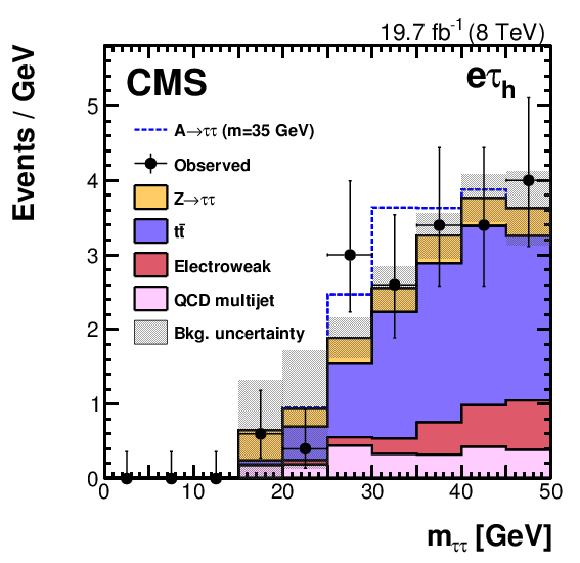
png pdf |
Figure 1-c:
Observed and predicted $m_{\tau \tau }$ distributions in the $\mu {\tau _\mathrm {h}} $ (a,b), $\mathrm{ e } {\tau _\mathrm {h}} $ (c,d), and $\mathrm{ e } \mu $ (e,f) channels. The plots on the left are the zoomed-in versions for $m_{\tau \tau }$ distributions below 50 GeV. A signal for a mass of $m_{\mathrm{A} }= $ 35 GeV is shown for a cross section of 40 pb. In $\mu {\tau _\mathrm {h}} $ and $\mathrm{ e } {\tau _\mathrm {h}} $ final states, the electroweak background is composed of $\mathrm{ Z } \to \mathrm{ e } \mathrm{ e } $, $\mathrm{ Z } \to \mu \mu $, W+jets, diboson, and single top quark contributions. In the $\mathrm{ e } \mu $ final state, the electroweak background is composed of diboson and single top backgrounds, while the misidentified $\mathrm{ e } /\mu $ background is due to QCD multijet and W+jets events. The contribution from the SM Higgs boson is negligible and therefore not shown. Expected background contributions are shown for the values of nuisance parameters (systematic uncertainties) obtained after fitting the signal + background hypothesis to the data. |

png pdf |
Figure 1-d:
Observed and predicted $m_{\tau \tau }$ distributions in the $\mu {\tau _\mathrm {h}} $ (a,b), $\mathrm{ e } {\tau _\mathrm {h}} $ (c,d), and $\mathrm{ e } \mu $ (e,f) channels. The plots on the left are the zoomed-in versions for $m_{\tau \tau }$ distributions below 50 GeV. A signal for a mass of $m_{\mathrm{A} }= $ 35 GeV is shown for a cross section of 40 pb. In $\mu {\tau _\mathrm {h}} $ and $\mathrm{ e } {\tau _\mathrm {h}} $ final states, the electroweak background is composed of $\mathrm{ Z } \to \mathrm{ e } \mathrm{ e } $, $\mathrm{ Z } \to \mu \mu $, W+jets, diboson, and single top quark contributions. In the $\mathrm{ e } \mu $ final state, the electroweak background is composed of diboson and single top backgrounds, while the misidentified $\mathrm{ e } /\mu $ background is due to QCD multijet and W+jets events. The contribution from the SM Higgs boson is negligible and therefore not shown. Expected background contributions are shown for the values of nuisance parameters (systematic uncertainties) obtained after fitting the signal + background hypothesis to the data. |

png pdf |
Figure 1-e:
Observed and predicted $m_{\tau \tau }$ distributions in the $\mu {\tau _\mathrm {h}} $ (a,b), $\mathrm{ e } {\tau _\mathrm {h}} $ (c,d), and $\mathrm{ e } \mu $ (e,f) channels. The plots on the left are the zoomed-in versions for $m_{\tau \tau }$ distributions below 50 GeV. A signal for a mass of $m_{\mathrm{A} }= $ 35 GeV is shown for a cross section of 40 pb. In $\mu {\tau _\mathrm {h}} $ and $\mathrm{ e } {\tau _\mathrm {h}} $ final states, the electroweak background is composed of $\mathrm{ Z } \to \mathrm{ e } \mathrm{ e } $, $\mathrm{ Z } \to \mu \mu $, W+jets, diboson, and single top quark contributions. In the $\mathrm{ e } \mu $ final state, the electroweak background is composed of diboson and single top backgrounds, while the misidentified $\mathrm{ e } /\mu $ background is due to QCD multijet and W+jets events. The contribution from the SM Higgs boson is negligible and therefore not shown. Expected background contributions are shown for the values of nuisance parameters (systematic uncertainties) obtained after fitting the signal + background hypothesis to the data. |
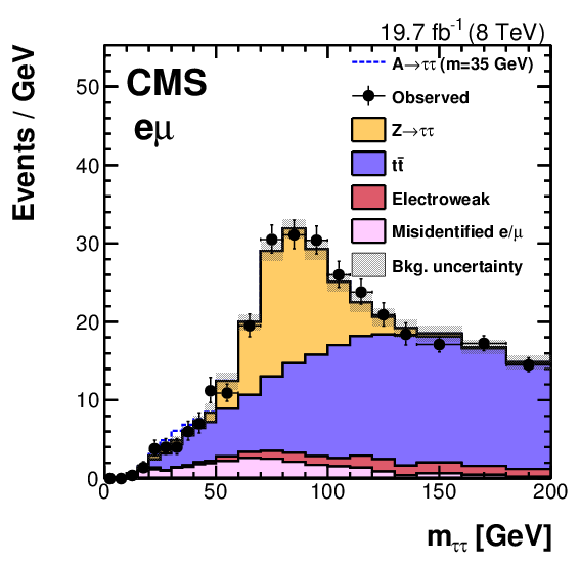
png pdf |
Figure 1-f:
Observed and predicted $m_{\tau \tau }$ distributions in the $\mu {\tau _\mathrm {h}} $ (a,b), $\mathrm{ e } {\tau _\mathrm {h}} $ (c,d), and $\mathrm{ e } \mu $ (e,f) channels. The plots on the left are the zoomed-in versions for $m_{\tau \tau }$ distributions below 50 GeV. A signal for a mass of $m_{\mathrm{A} }= $ 35 GeV is shown for a cross section of 40 pb. In $\mu {\tau _\mathrm {h}} $ and $\mathrm{ e } {\tau _\mathrm {h}} $ final states, the electroweak background is composed of $\mathrm{ Z } \to \mathrm{ e } \mathrm{ e } $, $\mathrm{ Z } \to \mu \mu $, W+jets, diboson, and single top quark contributions. In the $\mathrm{ e } \mu $ final state, the electroweak background is composed of diboson and single top backgrounds, while the misidentified $\mathrm{ e } /\mu $ background is due to QCD multijet and W+jets events. The contribution from the SM Higgs boson is negligible and therefore not shown. Expected background contributions are shown for the values of nuisance parameters (systematic uncertainties) obtained after fitting the signal + background hypothesis to the data. |
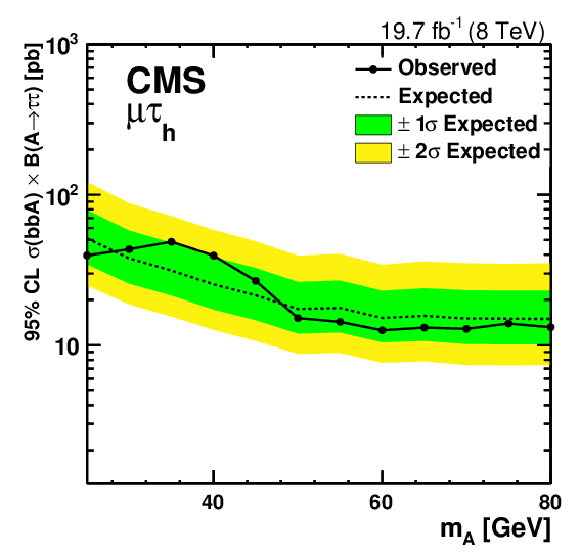
png pdf |
Figure 2-a:
Observed and expected upper limits at 95% CL on the product of cross section and branching fraction for a light pseudoscalar Higgs boson produced in association with two b quarks, that decays to two $\tau $ leptons, in the $\mu {\tau _\mathrm {h}} $ (a), $\mathrm{ e } {\tau _\mathrm {h}} $ (b), and $\mathrm{ e } \mu $ (c) channels. The 1$\sigma $ and 2$\sigma $ bands represent the 1 and 2 standard deviation uncertainties on the expected limits. |

png pdf |
Figure 2-b:
Observed and expected upper limits at 95% CL on the product of cross section and branching fraction for a light pseudoscalar Higgs boson produced in association with two b quarks, that decays to two $\tau $ leptons, in the $\mu {\tau _\mathrm {h}} $ (a), $\mathrm{ e } {\tau _\mathrm {h}} $ (b), and $\mathrm{ e } \mu $ (c) channels. The 1$\sigma $ and 2$\sigma $ bands represent the 1 and 2 standard deviation uncertainties on the expected limits. |

png pdf |
Figure 2-c:
Observed and expected upper limits at 95% CL on the product of cross section and branching fraction for a light pseudoscalar Higgs boson produced in association with two b quarks, that decays to two $\tau $ leptons, in the $\mu {\tau _\mathrm {h}} $ (a), $\mathrm{ e } {\tau _\mathrm {h}} $ (b), and $\mathrm{ e } \mu $ (c) channels. The 1$\sigma $ and 2$\sigma $ bands represent the 1 and 2 standard deviation uncertainties on the expected limits. |
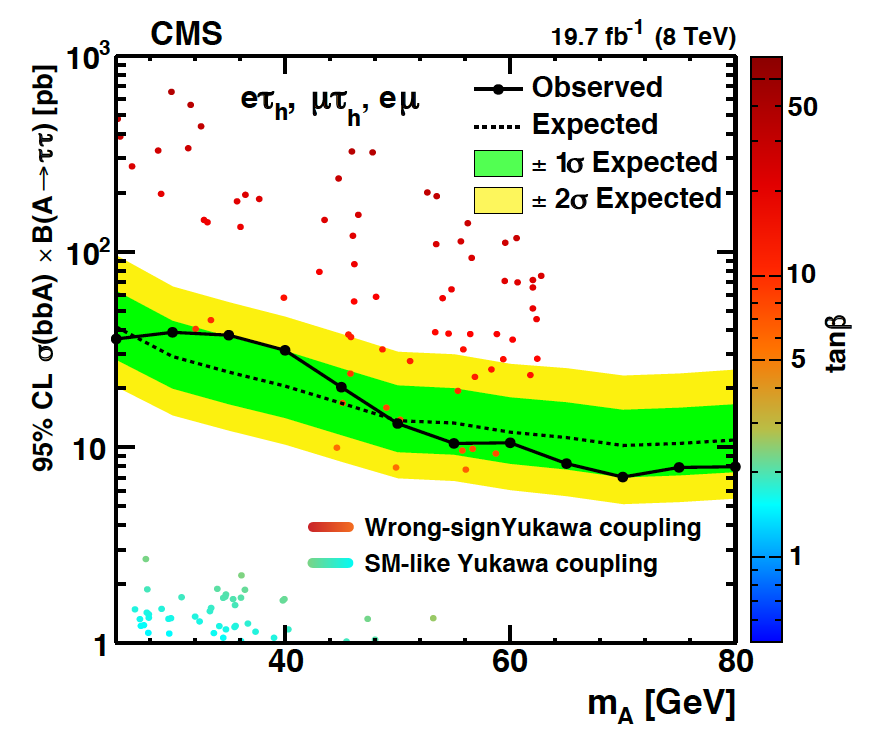
png pdf |
Figure 3:
Expected cross sections for TypeII 2HDM, superimposed on the expected and observed combined limits from this search. Cyan and green points, indicating small values of $\tan\beta $ as shown in the colour scale, have $\sin(\beta - \alpha ) \approx 1$, $\cos(\beta - \alpha ) > $ 0, and low $m_{12}^{2}$, and correspond to models with SM-like Yukawa coupling, while red and orange points, with large $\tan\beta $, have $\sin(\beta + \alpha ) \approx$ 1, small cos$(\beta - \alpha ) < $ 0 , and $\tan\beta > $ 5 , and correspond to the models with a ``wrong sign" Yukawa coupling. Theoretically viable points are shown only up to $m_{\mathrm{A} } = m_{\mathrm{h} }/2$ [19]. (For interpretation of the references to colour in this figure legend, the reader is referred to the web version of this article.) |
| Tables | |

png pdf |
Table 1:
Systematic uncertainties that affect the normalisation. |

png pdf |
Table 2:
Expected and observed combined upper limits at 95% CL in pb, along with their 1 and 2 standard deviation uncertainties, in the product of cross section and branching fraction for pseudoscalar Higgs bosons produced in association with ${\mathrm{ b \bar{b} } }$ pairs. |
| Summary |
| A search by the CMS experiment for a light pseudoscalar Higgs boson produced in association with a $\mathrm{ b \bar{b} }$ pair and decaying to a pair of $\tau$ leptons is reported. Three final states: ${\mu\tau_\mathrm{h}} $, ${\mathrm{ e }\tau_\mathrm{h}} $, and ${\mathrm{ e }\mu}$, are used where ${\tau_\mathrm{h}} $ represents a hadronic $\tau$ decay. The results are based on proton-proton collision data accumulated at a centre-of-mass energy of 8 TeV, corresponding to an integrated luminosity of 19.7 fb$^{-1}$. Pseudoscalar boson masses between 25 and 80 GeV are probed. No evidence for a pseudoscalar boson is found and upper limits are set on the product of cross section and branching fraction to $\tau$ pairs between 7 and 39 pb at the 95% confidence level. This excludes pseudoscalar A bosons with masses between 25 and 80 GeV, with SM-like Higgs boson negative couplings to down-type fermion, produced in association with $\mathrm{ b \bar{b} } $ pairs, in Type II, two-Higgs-doublet models. A search by the CMS experiment for a light pseudoscalar Higgs boson produced in association with a $\mathrm{ b \bar{b} }$ pair and decaying to a pair of $\tau$ leptons is reported. Three final states: $\mu {\tau_\mathrm {h}}$, $\mathrm{e} {\tau _\mathrm {h}}$, and $\mathrm{e} \mu$, are used where $\tau _\mathrm {h}$ represents a hadronic $\tau$ decay. The results are based on proton-proton collision data accumulated at a centre-of-mass energy of 8 TeV, corresponding to an integrated luminosity of 19.7 fb$^{-1}$. Pseudoscalar boson masses between 25 and 80 GeV are probed. No evidence for a pseudoscalar boson is found and upper limits are set on the production cross section times branching fraction to $\tau$ pairs between 7 and 39 pb at the 95% confidence level. This excludes a pseudoscalar A boson with a mass below 80 GeV, produced in association with a $\mathrm{ b \bar{b} }$ pair in Type-II 2HDMs with SM-like h boson negative couplings to down-type fermions. |
| Additional Figures | |
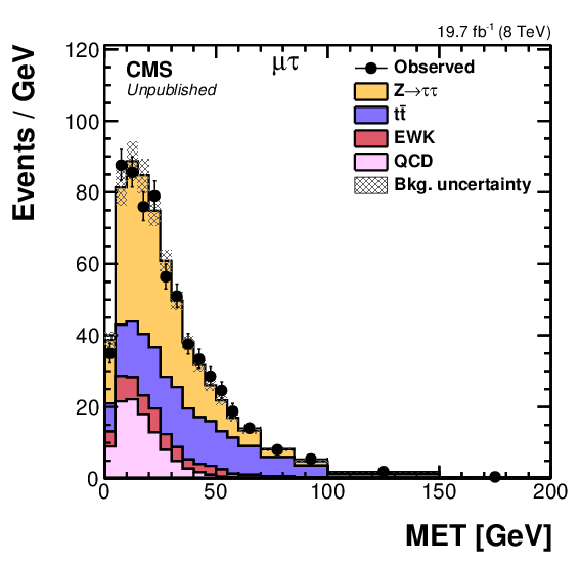
png pdf |
Additional Figure 1:
Observed and predicted transverse missing energy distributions in the $\mu\tau_h$ channel. The electroweak background is composed of $\mathrm{Z}\rightarrow \mathrm{ee}$, $\mathrm{Z}\rightarrow\mu\mu$, W+jets, diboson, and single top quark contributions. The contribution from the SM Higgs boson and from the signal are negligible and therefore not shown. A maximum likelihood fit to data, taking into account systematic uncertainties, is performed. |

png pdf |
Additional Figure 2:
Observed and predicted distributions of the hadronic tau transverse momentum in the $\mu\tau_h$ channel. The electroweak background is composed of $\mathrm{Z}\rightarrow \mathrm{ee}$, $\mathrm{Z}\rightarrow\mu\mu$, W+jets, diboson, and single top quark contributions. The contribution from the SM Higgs boson and from the signal are negligible and therefore not shown. A maximum likelihood fit to data, taking into account systematic uncertainties, is performed. |
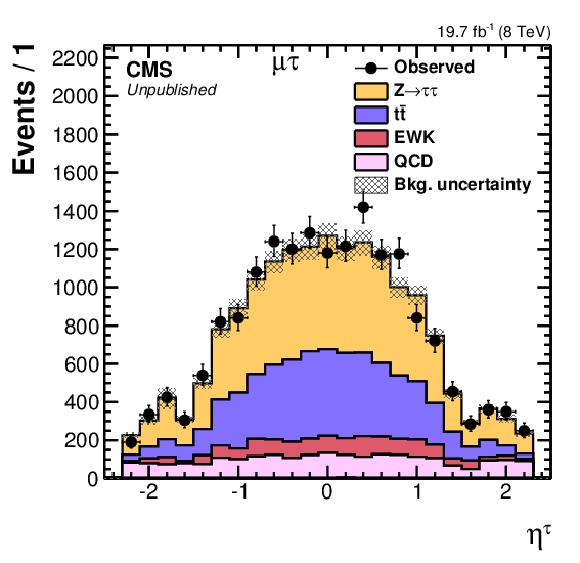
png pdf |
Additional Figure 3:
Observed and predicted distributions of the hadronic tau pseudorapidity in the $\mu\tau_h$ channel. The electroweak background is composed of $\mathrm{Z}\rightarrow \mathrm{ee}$, $\mathrm{Z}\rightarrow\mu\mu$, W+jets, diboson, and single top quark contributions. The contribution from the SM Higgs boson and from the signal are negligible and therefore not shown. A maximum likelihood fit to data, taking into account systematic uncertainties, is performed. |

png pdf |
Additional Figure 4:
Observed and predicted distributions of the muon pseudorapidity in the $\mu\tau_h$ channel. The electroweak background is composed of $\mathrm{Z}\rightarrow \mathrm{ee}$, $\mathrm{Z}\rightarrow\mu\mu$, W+jets, diboson, and single top quark contributions. The contribution from the SM Higgs boson and from the signal are negligible and therefore not shown. A maximum likelihood fit to data, taking into account systematic uncertainties, is performed. |
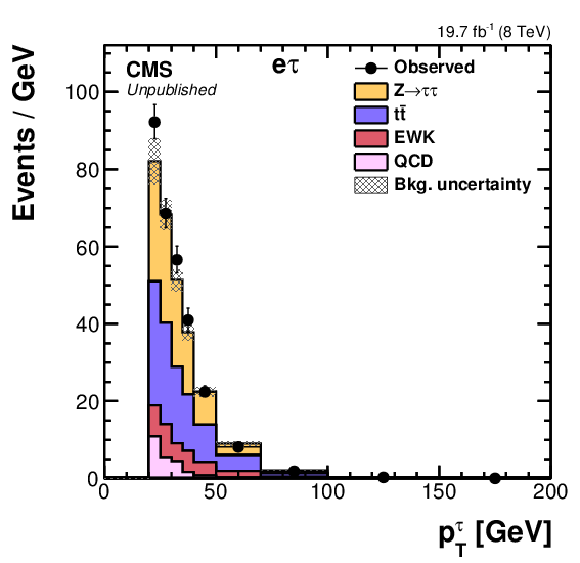
png pdf |
Additional Figure 5:
Observed and predicted distributions of the hadronic tau transverse momentum in the $\mathrm{e}\tau_h$ channel. The electroweak background is composed of $\mathrm{Z}\rightarrow \mathrm{ee}$, $\mathrm{Z}\rightarrow\mu\mu$, W+jets, diboson, and single top quark contributions. The contribution from the SM Higgs boson and from the signal are negligible and therefore not shown. A maximum likelihood fit to data, taking into account systematic uncertainties, is performed. |
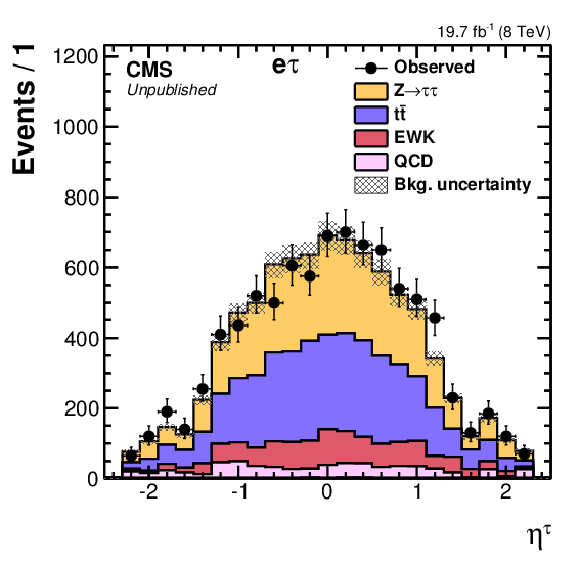
png pdf |
Additional Figure 6:
Observed and predicted distributions of the hadronic tau pseudorapidity in the $\mathrm{e}\tau_h$ channel. The electroweak background is composed of $\mathrm{Z}\rightarrow \mathrm{ee}$, $\mathrm{Z}\rightarrow\mu\mu$, W+jets, diboson, and single top quark contributions. The contribution from the SM Higgs boson and from the signal are negligible and therefore not shown. A maximum likelihood fit to data, taking into account systematic uncertainties, is performed. |
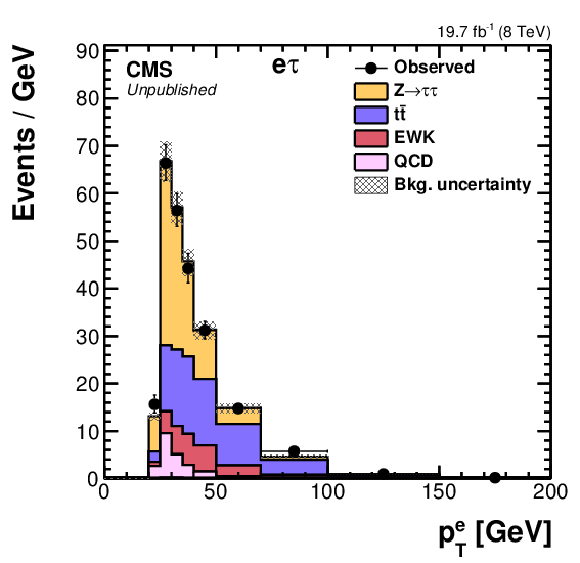
png pdf |
Additional Figure 7:
Observed and predicted distributions of the electron transverse momentum in the $\mathrm{e}\tau_h$ channel. The electroweak background is composed of $\mathrm{Z}\rightarrow \mathrm{ee}$, $\mathrm{Z}\rightarrow\mu\mu$, W+jets, diboson, and single top quark contributions. The contribution from the SM Higgs boson and from the signal are negligible and therefore not shown. A maximum likelihood fit to data, taking into account systematic uncertainties, is performed. |

png pdf |
Additional Figure 8:
Observed and predicted distributions of the electron pseudorapidity in the $\mathrm{e}\tau_h$ channel. The electroweak background is composed of $\mathrm{Z}\rightarrow \mathrm{ee}$, $\mathrm{Z}\rightarrow\mu\mu$, W+jets, diboson, and single top quark contributions. The contribution from the SM Higgs boson and from the signal are negligible and therefore not shown. A maximum likelihood fit to data, taking into account systematic uncertainties, is performed. |
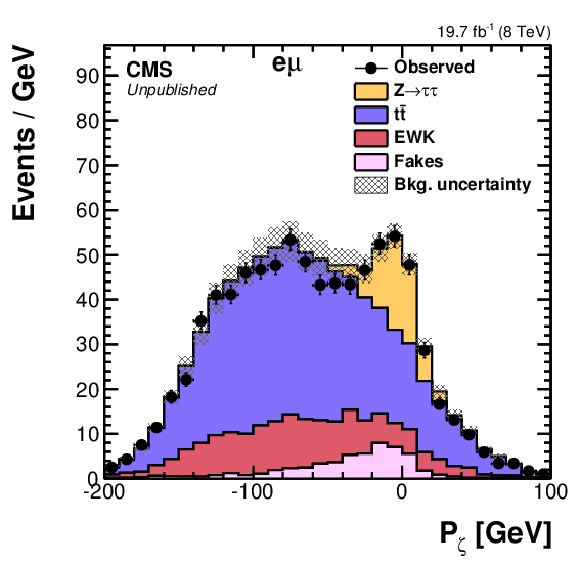
png pdf |
Additional Figure 9:
Observed and predicted distributions of the $P_\zeta$ variable in the $\mathrm{e}\mu$ channel. the electroweak background is composed of diboson and single top backgrounds, while the misidentified $\mathrm{e}/\mu$ background is due to QCD multijet and W+jets events. The contribution from the SM Higgs boson and from the signal are negligible and therefore not shown. A maximum likelihood fit to data, taking into account systematic uncertainties, is performed. |
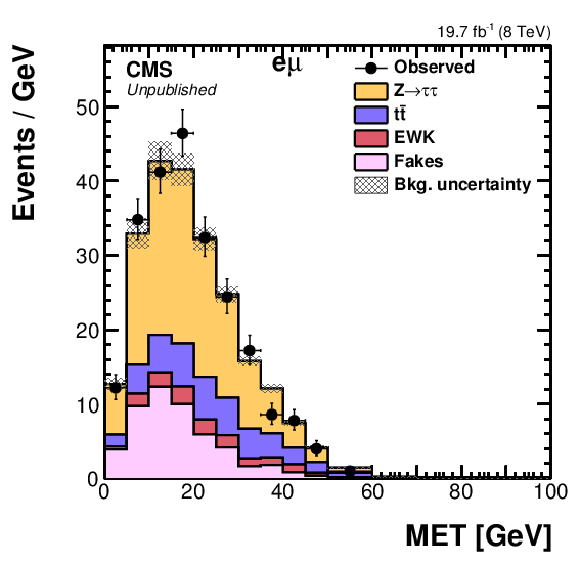
png pdf |
Additional Figure 10:
Observed and predicted distributions of the transverse missing energy in the $\mathrm{e}\mu$ channel. the electroweak background is composed of diboson and single top backgrounds, while the misidentified $\mathrm{e}/\mu$ background is due to QCD multijet and W+jets events. The contribution from the SM Higgs boson and from the signal are negligible and therefore not shown. A maximum likelihood fit to data, taking into account systematic uncertainties, is performed. |
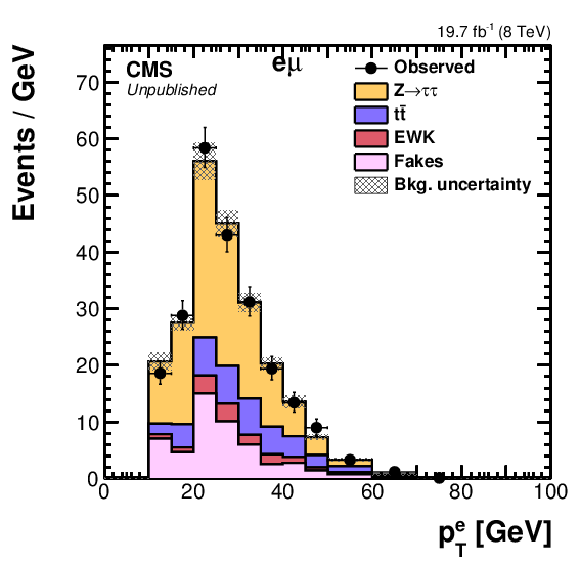
png pdf |
Additional Figure 11:
Observed and predicted distributions of the electron transverse momentum in the $\mathrm{e}\mu$ channel. the electroweak background is composed of diboson and single top backgrounds, while the misidentified $\mathrm{e}/\mu$ background is due to QCD multijet and W+jets events. The contribution from the SM Higgs boson and from the signal are negligible and therefore not shown. A maximum likelihood fit to data, taking into account systematic uncertainties, is performed. |
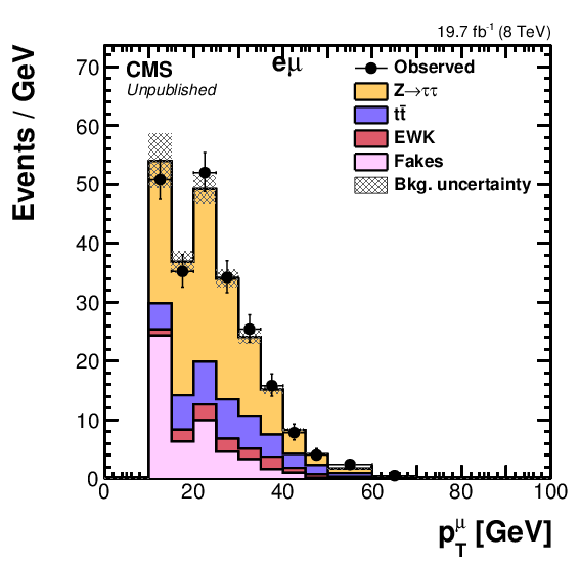
png pdf |
Additional Figure 12:
Observed and predicted distributions of the muon transverse moemntum in the $\mathrm{e}\mu$ channel. the electroweak background is composed of diboson and single top backgrounds, while the misidentified $\mathrm{e}/\mu$ background is due to QCD multijet and W+jets events. The contribution from the SM Higgs boson and from the signal are negligible and therefore not shown. A maximum likelihood fit to data, taking into account systematic uncertainties, is performed. |

png pdf |
Additional Figure 13:
Signal acceptance times efficiency for different pseudoscalar Higgs boson mass hypotheses, in the $\mu\tau_h$ (points), $\mathrm{e}\mu$ (squares) and $\mathrm{e}\tau_h$ (triangles) channels. |
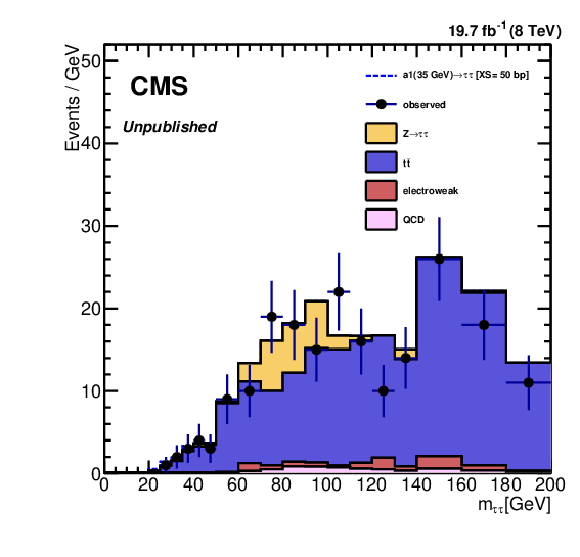
png pdf |
Additional Figure 14:
Observed and predicted distributions of the $\tau\tau$ mass in the $\mu\tau_h$ channel. The $ p_{ \mathrm{T} } $ threshold of muon, tau and 2 jets are raised to 30 GeV to obtain a control region that is largely dominated by $ \mathrm{ t \bar{t} } $ events. The agreement between prediction and observation validate the normalisation and distribution estimation of $ \mathrm{ t \bar{t} } $ background in signal region. |
| References | ||||
| 1 | ATLAS Collaboration | Observation of a new particle in the search for the Standard Model Higgs boson with the ATLAS detector at the LHC | PLB 716 (2012) 1 | 1207.7214 |
| 2 | CMS Collaboration | Observation of a new boson at a mass of 125 GeV with the CMS experiment at the LHC | PLB 716 (2012) 30 | CMS-HIG-12-028 1207.7235 |
| 3 | CMS Collaboration | Observation of a new boson with mass near 125 GeV in pp collisions at $ \sqrt{s} = $ 7 and 8 TeV | JHEP 06 (2013) 081 | CMS-HIG-12-036 1303.4571 |
| 4 | ATLAS Collaboration | Measurement of the Higgs boson mass from the $ H\rightarrow \gamma\gamma $ and $ H\rightarrow ZZ^* \rightarrow 4\ell $ channels in pp collisions at center-of-mass energies 7 and 8 TeV with the ATLAS detector | PRD 90 (2014) 052004 | 1406.3827 |
| 5 | CMS Collaboration | Precise determination of the mass of the Higgs boson and tests of compatibility of its couplings with the standard model predictions using proton collisions at 7 and 8 TeV | EPJC 75 (2015) 212 | CMS-HIG-14-009 1412.8662 |
| 6 | J. Wess and B. Zumino | Supergauge transformations in four dimensions | Nucl. Phys. B 70 (1974) 39 | |
| 7 | H.-C. Cheng and I. Low | TeV symmetry and the little hierarchy problem | JHEP 09 (2003) 051 | hep-ph/0308199 |
| 8 | T. Appelquist, H.-C. Cheng, and B. A. Dobrescu | Bounds on universal extra dimensions | PRD 64 (2001) 035002 | hep-ph/0012100 |
| 9 | G. Bertone, D. Hooper, and J. Silk | Particle dark matter: evidence, candidates and constraints | PR 405 (2005) 279 | hep-ph/0404175 |
| 10 | T. D. Lee | A theory of spontaneous T violation | PRD 8 (1973) 1226 | |
| 11 | N. G. Deshpande and E. Ma | Pattern of symmetry breaking with two Higgs doublets | PRD 18 (1978) 2574 | |
| 12 | N. G. Deshpande and E. Ma | The fermion mass scale and possible effects of Higgs bosons on experimental observables | Nucl. Phys. B 161 (1979) 493 | |
| 13 | J. F. Gunion, H. E. Haber, G. L. Kane, and S. Dawson | The Higgs Hunter's Guide | volume 80 of Frontiers in Physics Perseus Books | |
| 14 | G. C. Branco et al. | Theory and phenomenology of two-Higgs-doublet models | Phys. Rep. 516 (2012) 1 | 1106.0034 |
| 15 | S. Glashow and S. Weinberg | Natural conservation laws for neutral currents | PRD 15 (1958) | |
| 16 | H. E. Haber and Y. Nir | Multi-scalar models with a high-energy scale | Nucl. Phys. B 335 (1990) 363 | |
| 17 | J. F. Gunion and H. E. Haber | The CP-conserving two-Higgs-doublet model: the approach to the decoupling limit | PRD 67 (2003) 075019 | hep-ph/0207010 |
| 18 | B. Dumont, J. F. Gunion, Y. Jiang, and S. Kraml | Constraints on and future prospects for two-Higgs-doublet models in light of the LHC Higgs signal | PRD 90 (2014) 035021 | 1405.3584v1 |
| 19 | J. Bernon, J. F. Gunion, Y. Jiang, and S. Kraml | Light Higgs bosons in two-Higgs-doublet models | PRD 91 (2015) 075019 | 1412.3385 |
| 20 | ATLAS Collaboration | Search for neutral Higgs bosons of the minimal supersymmetric standard model in pp collisions at $ \sqrt{s} = $ 8 TeV with the ATLAS detector | JHEP 11 (2014) 056 | 1409.6064 |
| 21 | CMS Collaboration | Search for neutral MSSM Higgs bosons decaying to a pair of tau leptons in pp collisions | JHEP 10 (2014) 160 | CMS-HIG-13-021 1408.3316 |
| 22 | P. Fayet | Supergauge invariant extension of the Higgs mechanism and a model for the electron and its neutrino | Nucl. Phys. B 90 (1975) 104 | |
| 23 | P. Fayet | Supersymmetry and weak, electromagnetic and strong interactions | PLB 64 (1976) 159 | |
| 24 | P. Fayet | Spontaneously broken supersymmetric theories of weak, electromagnetic and strong interactions | PLB 69 (1977) 489 | |
| 25 | J. Kozaczuk and T. A. W. Martin | Extending LHC coverage to light pseudoscalar mediators and coy dark sectors | JHEP 04 (2015) 046 | 1501.07275 |
| 26 | CMS Collaboration | The CMS experiment at the CERN LHC | JINST 3 (2008) S08004 | CMS-00-001 |
| 27 | F. Maltoni and T. Stelzer | MadEvent: automatic event generation with MadGraph | JHEP 02 (2003) 027 | hep-ph/0208156 |
| 28 | S. Frixione, P. Nason, and C. Oleari | Matching NLO QCD computations with parton shower simulations: the POWHEG method | JHEP 11 (2007) 070 | 0709.2092 |
| 29 | T. Sj\"ostrand, S. Mrenna, and P. Skands | PYTHIA 6.4 physics and manual | JHEP 05 (2006) 026 | hep-ph/0603175 |
| 30 | Pumplin, J. and Stump, D. R. and Huston, J. and Lai, H.-L. and Nadolsky, P. and Tung, W.-K. | New generation of parton distributions with uncertainties from global QCD analysis | JHEP 07 (2002) 012 | hep-ph/0201195 |
| 31 | GEANT4 Collaboration | GEANT4---a simulation toolkit | NIMA 506 (2003) 250 | |
| 32 | CMS Collaboration | Particle--flow event reconstruction in CMS and performance for jets, taus, and $ E_{\mathrm{T}}^{\text{miss}} $ | CDS | |
| 33 | CMS Collaboration | Commissioning of the particle-flow event reconstruction with the first LHC collisions recorded in the CMS detector | CDS | |
| 34 | K. Rose | Deterministic annealing for clustering, compression, classification, regression and related optimisation problems | in Proceedings of the IEEE, volume 86, p. 2210Ð2239 1998 | |
| 35 | W. Waltenberger, R. Fr\"uhwirth, and P. Vanlaer | Adaptive vertex fitting | JPG 34 (2007) N343 | |
| 36 | CMS Collaboration | Performance of CMS muon reconstruction in pp collision events at $ \sqrt{s} = $ 7 TeV | JINST 7 (2012) P10002 | CMS-MUO-10-004 1206.4071 |
| 37 | CMS Collaboration | Determination of jet energy calibration and transverse momentum resolution in CMS | JINST 6 (2011) P11002 | CMS-JME-10-011 1107.4277 |
| 38 | W. Adam, R. Fr\"uhwirth, A. Strandlie, and T. Todorov | Reconstruction of electrons with the Gaussian-sum filter in the CMS tracker at the LHC | JPG 31 (2005) N9 | physics/0306087 |
| 39 | H. Voss, A. H\"ocker, J. Stelzer, and F. Tegenfeldt | TMVA, the toolkit for multivariate data analysis with ROOT | in XIth International Workshop on Advanced Computing and Analysis Techniques in Physics Research (ACAT), p. 40 2007 | physics/0703039 |
| 40 | CMS Collaboration | Performance of electron reconstruction and selection with the CMS detector in proton-proton collisions at $ \sqrt{s} = $ 8 TeV | JINST 10 (2015) P06005 | CMS-EGM-13-001 1502.02701 |
| 41 | M. Cacciari, G. P. Salam, and G. Soyez | The anti-$ k_t $ jet clustering algorithm | JHEP 04 (2008) 063 | 0802.1189 |
| 42 | M. Cacciari, G. P. Salam, and G. Soyez | FastJet user manual | EPJC 72 (2012) 1896 | 1111.6097 |
| 43 | CMS Collaboration | Pileup jet identification | CMS-PAS-JME-13-005 | CMS-PAS-JME-13-005 |
| 44 | CMS Collaboration | Identification of b-quark jets with the CMS experiment | JINST 8 (2013) P04013 | CMS-BTV-12-001 1211.4462 |
| 45 | CMS Collaboration | Performance of tau-lepton reconstruction and identification in CMS | JINST 7 (2012) P01001 | CMS-TAU-11-001 1109.6034 |
| 46 | CMS Collaboration | Reconstruction and identification of $ \tau $ lepton decays to hadrons and $ \nu_\tau $ at CMS | JINST 11 (2016), no. 01, P01019 | CMS-TAU-14-001 1510.07488 |
| 47 | CMS Collaboration | Performance of the CMS missing transverse momentum reconstruction in pp data at $ \sqrt{s} = $ 8 TeV | JINST 10 (2015) P02006 | CMS-JME-13-003 1411.0511 |
| 48 | L. Bianchini, J. Conway, E. K. Friis, and C. Veelken | Reconstruction of the Higgs mass in $ H \to \tau\tau $ events by dynamical likelihood techniques | J. Phys. Conf. Ser. 513 (2014) 022035 | 1603.05910 |
| 49 | CDF Collaboration | Search for MSSM Higgs decaying to tau pairs | CDF Public Note 7161 | |
| 50 | S. Jadach, Z. Was, R. Decker, and J. H. Kuhn | The tau decay library Tauola: Version 2.4 | CPC 76 (1993) 361 | |
| 51 | CMS Collaboration | Evidence for the 125$ GeV $ Higgs boson decaying to a pair of $ \tau $ leptons | JHEP 05 (2014) 104 | CMS-HIG-13-004 1401.5041 |
| 52 | CMS Collaboration | Measurement of the differential cross section for top quark pair production in pp collisions at $ \sqrt{s} = 8\,\text {TeV} $ | EPJC 75 (2015), no. 11, 542 | CMS-TOP-12-028 1505.04480 |
| 53 | CMS Collaboration | Observation of the associated production of a single top quark and a $ W $ boson in $ pp $ collisions at $ \sqrt s = $8 TeV | PRL 112 (2014), no. 23, 231802 | CMS-TOP-12-040 1401.2942 |
| 54 | J. M. Campbell, R. K. Ellis, and C. Williams | Vector boson pair production at the LHC | JHEP 07 (2011) 018 | 1105.0020 |
| 55 | CMS Collaboration | Measurement of the inclusive W and Z production cross sections in pp collisions at $ \sqrt{s} = $ 7 TeV with the CMS experiment | JHEP 10 (2011) 132 | CMS-EWK-10-005 1107.4789 |
| 56 | CMS Collaboration | CMS luminosity based on pixel cluster counting --- Summer 2013 update | CMS-PAS-LUM-13-001 | CMS-PAS-LUM-13-001 |
| 57 | CMS Collaboration | Measurement of W$ ^+ $W$ ^- $ and ZZ production cross sections in pp collisions at $ \sqrt{s} = 8 $ TeV | PLB 721 (2013) 190 | CMS-SMP-12-024 1301.4698 |
| 58 | S. Alekhin et al. | The PDF4LHC Working Group interim report | 1101.0536 | |
| 59 | A. D. Martin, W. J. Stirling, R. S. Thorne, and G. Watt | Parton distributions for the LHC | EPJC 63 (2009) 189 | 0901.0002 |
| 60 | R. D. Ball et al. | Parton distributions with LHC data | Nucl. Phys. B 867 (2012) 244 | 1207.1303 |
| 61 | J. Alwall et al. | The automated computation of tree-level and next-to-leading order differential cross sections, and their matching to parton shower simulations | JHEP 07 (2014) 079 | 1405.0301 |
| 62 | CMS Collaboration | Measurement of differential top-quark pair production cross sections in $ pp $ collisions at $ \sqrt{s}=7 $ TeV | EPJC 73 (2013), no. 3 | CMS-TOP-11-013 1211.2220 |
| 63 | R. Barlow and C. Beeston | Fitting using finite Monte Carlo samples | Comp. Phys. Comm. 77 (1993) 219 | |
| 64 | A. L. Read | Presentation of search results: the $ \rm CL_s $ technique | JPG 28 (2002) 2693 | |
| 65 | T. Junk | Confidence level computation for combining searches with small statistics | NIMA 434 (1999) 435 | hep-ex/9902006 |
| 66 | G. Cowan, K. Cranmer, E. Gross, and O. Vitells | Asymptotic formulae for likelihood-based tests of new physics | EPJC 71 (2011) 1554, , [Erratum: \DOI10.1140/epjc/s10052-013-2501-z] | 1007.1727 |
| 67 | ATLAS and CMS, LHC Higgs Combination Group | Procedure for the LHC Higgs boson search combination in Summer 2011 | Technical Report ATL-PHYS-PUB 2011-11, CMS NOTE 2011/005, CERN | |

|
Compact Muon Solenoid LHC, CERN |

|

|

|

|

|

|